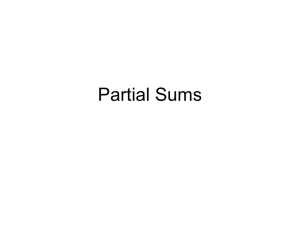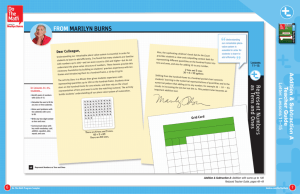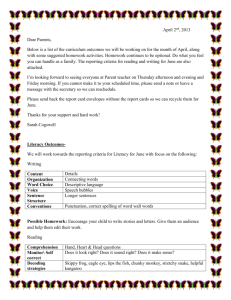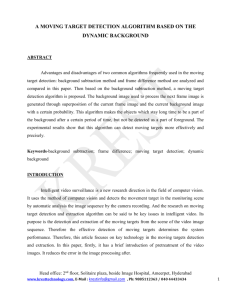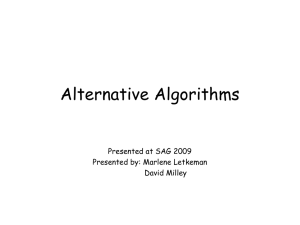Curriculum Map Math
advertisement
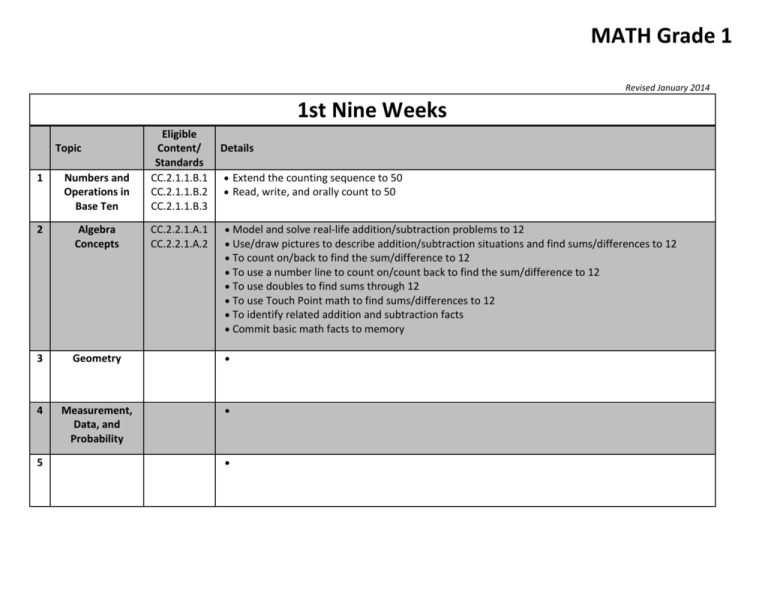
MATH Grade 1 Revised January 2014 1st Nine Weeks 1 Numbers and Operations in Base Ten Eligible Content/ Standards CC.2.1.1.B.1 CC.2.1.1.B.2 CC.2.1.1.B.3 2 Algebra Concepts CC.2.2.1.A.1 CC.2.2.1.A.2 3 Geometry 4 Measurement, Data, and Probability Topic 5 Details Extend the counting sequence to 50 Read, write, and orally count to 50 Model and solve real-life addition/subtraction problems to 12 Use/draw pictures to describe addition/subtraction situations and find sums/differences to 12 To count on/back to find the sum/difference to 12 To use a number line to count on/count back to find the sum/difference to 12 To use doubles to find sums through 12 To use Touch Point math to find sums/differences to 12 To identify related addition and subtraction facts Commit basic math facts to memory MATH Grade 1 2nd Nine Weeks 1 Numbers and Operations in Base Ten Eligible Content/ Standards CC.2.1.1.B.1 CC.2.1.1.B.2 CC.2.1.1.B.3 2 Algebra Concepts CC.2.2.1.A.1 CC.2.2.1.A.2 Topic Details Extend the counting sequence to 120 Read, write, and orally count to 120 Understand that a two-digit number can be represented with tens and ones Compare the two-digit numbers using >, =, < Given a two-digit number, add ten more or ten less than the number Model and solve real-life addition problems to 12 Use/draw pictures to describe addition situations and find sums to 12 To count on to find the sum to 12 To use a number line to count on to find the sum to 12 To use doubles to find sums through 12 To use Touch Point math to find sums to 12 Commit basic math facts to memory To identify related addition and subtraction facts as fact families Solve word problems that call for addition of three whole numbers whose sum is less than or equal to 12 To identify related addition and subtraction facts as fact families 3 Geometry 4 Measurement, Data, and Probability 5 CC.2.4.1.A.1 CC.2.4.1.A.2 CC.2.4.1.A.4 MATH Grade 1 MATH Grade 1 3rd Nine Weeks 1 Numbers and Operations in Base Ten Eligible Content/ Standards CC.2.1.1.B.1 CC.2.1.1.B.2 CC.2.1.1.B.3 2 Algebra Concepts CC.2.2.1.A.1 CC.2.2.1.A.2 Model and solve real-life addition and subtraction problems to 20 Use/draw pictures to describe addition and subtraction situations and find differences to 20 To count back to find the difference to 20 Count up to find sums to 20 To use a number line to find sums and differences to 20 To use doubles to find sums and differences through 20 To use Touch Point math to find sums and differences to 20 Commit basic math facts to memory 3 Geometry CC.2.3.1.A.1 CC.2.3.1.A.2 Compose and distinguish between two (rectangles, squares, trapezoids, triangles, half circles, and Topic 4 5 Measurement, Data, and Probability CC.2.4.1.A.1 CC.2.4.1.A.2 CC.2.4.1.A.4 Details quarter circles) and three (cubes, right rectangular prisms, right circular cones, right circular cylinders) dimensional shapes based on their attributes Use the understanding of fractions to partition shapes into halves and quarters Tell and write time to, the nearest hour and half hour, using both analog and digital clocks. MATH Grade 1 4th Nine Weeks 1 Numbers and Operations in Base Ten Eligible Content/ Standards CC.2.1.1.B.1 CC.2.1.1.B.2 CC.2.1.1.B.3 2 Algebra Concepts CC.2.2.1.A.1 CC.2.2.1.A.2 Model and solve real-life addition and subtraction problems to 20 Use/draw pictures to describe addition and subtraction situations and find differences to 20 Determine the unknown number in an addition or subtraction fact To add and subtract two- digit numbers using place value up to 100 without regrouping Solve word problems up to 100 Commit math facts to memory 3 Geometry CC.2.3.1.A.1 CC.2.3.1.A.2 4 Measurement, Data, and Probability CC.2.4.1.A.1 CC.2.4.1.A.2 CC.2.4.1.A.4 Order lengths and measure them both indirectly and by repeating length units Represent and interpret data using tables/charts Topic Details 5 6 7 MATH Grade 1



